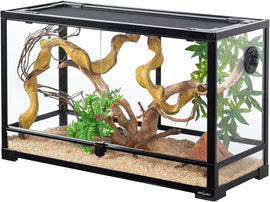Hognose snakes, known for their distinctive upturned snout and playful nature, are popular reptile pets among enthusiasts. Providing a suitable hognose snake enclosure is essential to ensure their well-being and happiness in captivity. In this article, we will explore the key elements to consider when setting up the perfect hognose snake enclosure, including habitat design, temperature and humidity control, and other essential care tips.
Selecting the Right Enclosure
When creating a hognose snake enclosure, the first decision you'll need to make is the type of enclosure. Several options are available, each with its advantages and considerations:
Glass Terrariums: Glass enclosures are popular for their visibility and aesthetics. A 20-gallon long tank is a suitable size for an adult hognose snake. Ensure that it has a secure, escape-proof lid.
Plastic Tubs: Plastic tubs are a cost-effective and practical choice. They provide excellent heat retention and can be easy to maintain. However, they may not offer the same visibility as glass.
PVC Cages: PVC cages offer a durable and low-maintenance solution. They come in various sizes and are well-suited for creating a comfortable environment for hognose snakes.
Custom Enclosures: Some enthusiasts choose to design custom enclosures to meet the specific needs of their hognose snake. These enclosures can be tailored to provide ample space and features like climbing opportunities and hides.
Creating the Perfect Hognose Snake Enclosure: A Guide to a Happy and Healthy Habitat
Habitat Design
A well-designed hognose snake enclosure should mimic their natural habitat and provide the following elements:
Substrate: Use an appropriate substrate that allows burrowing. Aspen shavings, cypress mulch, or coconut coir are good options. The substrate should be deep enough for your snake to burrow and hide comfortably.
Hides: Hognose snakes are known for their burrowing behavior. Provide multiple hides in the enclosure, including a warm hide and a cooler hide, to give your snake options for temperature regulation.
Branches and Climbing Opportunities: Even though hognose snakes are primarily terrestrial, they may enjoy climbing on branches or logs. Including a few opportunities for your snake to explore vertically can enhance their enclosure.
Foliage and Decor: Adding artificial or live plants can create a more natural and aesthetically pleasing environment. Ensure that any live plants are non-toxic to your snake.
Water Bowl: A shallow water bowl should be available for drinking and soaking. Ensure that the water is always clean and free of contaminants.
Temperature and Humidity Control
Maintaining the right temperature and humidity levels in your hognose snake enclosure is crucial for their health and comfort. Here are the key considerations:
Temperature: Hognose snakes are native to North America and require a thermal gradient in their enclosure.
Provide a warm side with a temperature of around 85-90°F (29-32°C) and a cool side around 75-80°F (24-27°C). Use heat pads, ceramic heat emitters, or heat lamps to create the appropriate temperature gradient.
Humidity: Hognose snakes require moderate humidity levels, typically around 40-50%. Ensure that the substrate stays slightly moist to provide adequate humidity. Provide a humidity hide or box filled with damp sphagnum moss for shedding assistance.
Lighting: Hognose snakes are generally crepuscular or nocturnal, so they don't require special UVB lighting.
However, a natural light cycle with a day-night cycle of 12 hours each can help regulate their behavior.
Feeding and Handling
Hognose snakes are generally insectivores and have a diet primarily composed of amphibians and reptiles in the wild. In captivity, they can be fed a diet of appropriately sized rodents and occasionally supplemented with other prey items, such as insects. Ensure that the prey is appropriately sized for the snake's girth, typically no larger than the snake's widest point.
When handling your hognose snake, be gentle and avoid sudden movements. Hognose snakes are known for their unique defensive behaviors, which include hissing, spreading their necks to appear larger, and even playing dead. While they are generally harmless, handling should be done with care to avoid causing stress.
Common Health Concerns
Proper hognose snake care includes monitoring their health and being aware of common health issues such as respiratory infections, scale rot, or mites. Regular check-ups by a veterinarian who specializes in reptiles are advisable to ensure your snake's well-being.
For More Info :-















